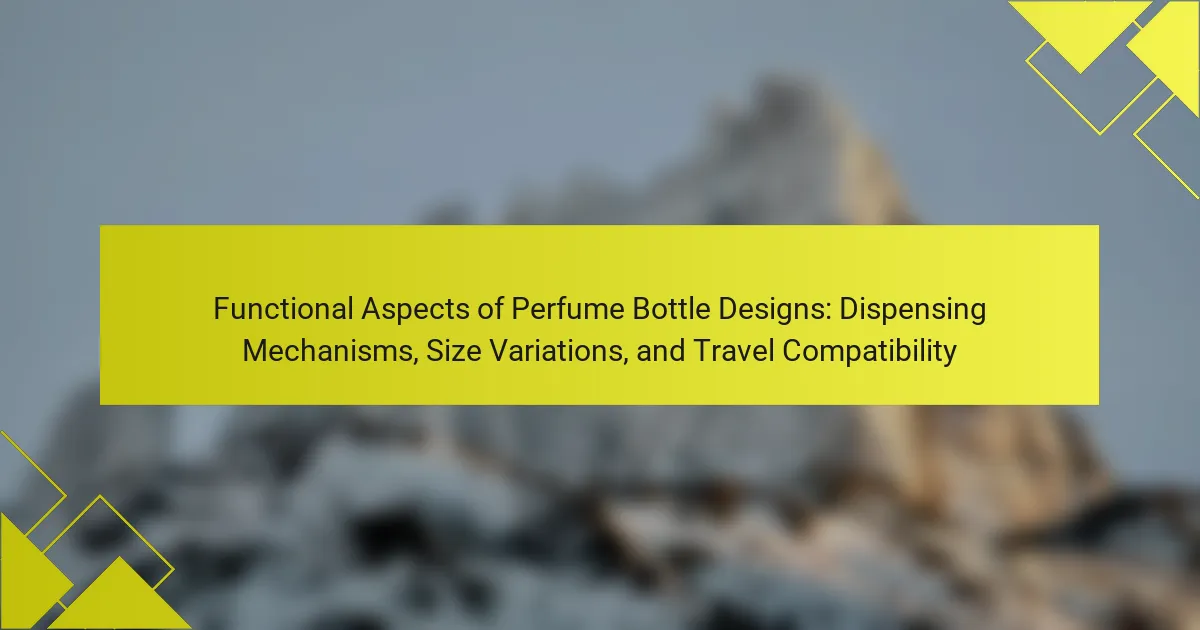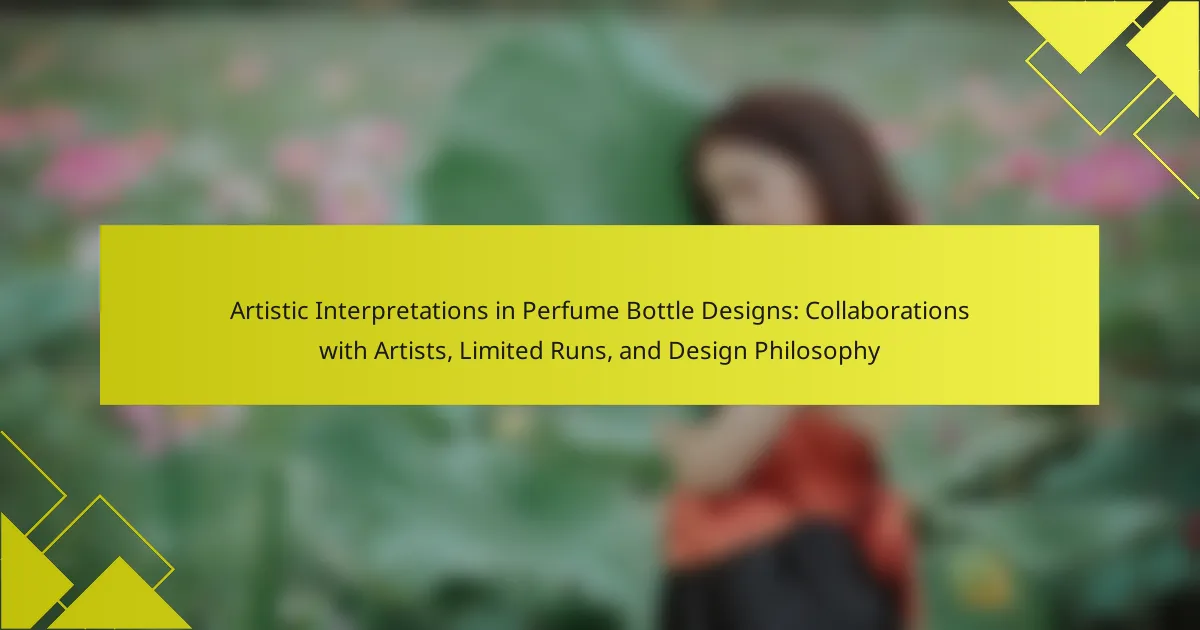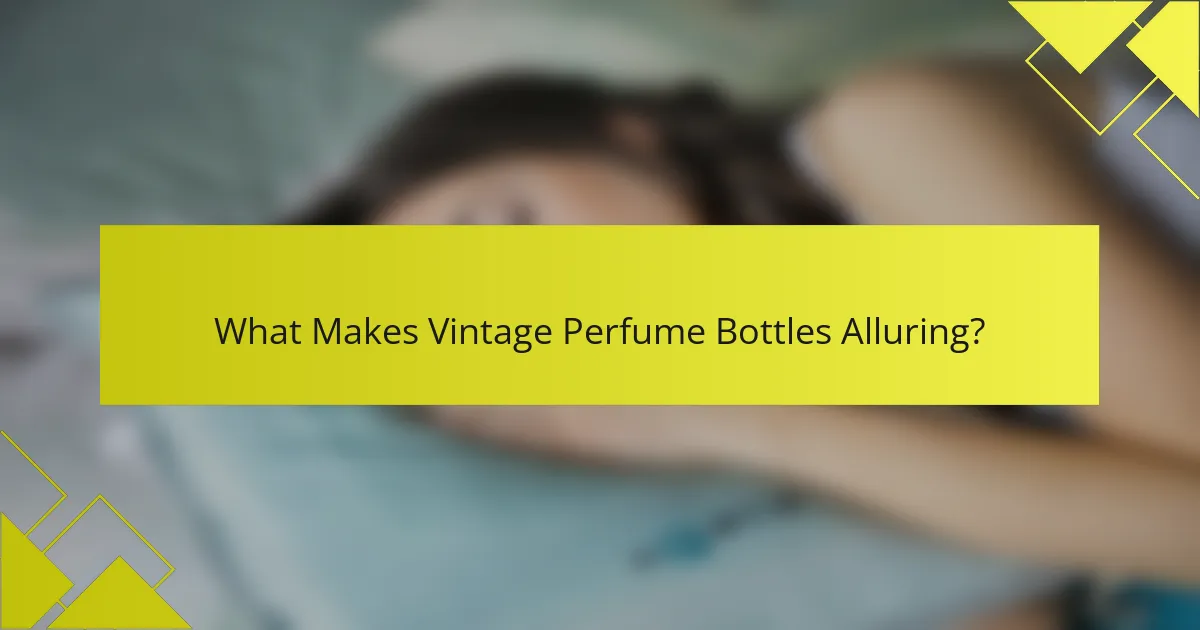
What Makes Vintage Perfume Bottles Alluring?
Vintage perfume bottles are alluring due to their unique designs and historical significance. These bottles often feature intricate craftsmanship, showcasing artistic styles from various eras. Many vintage bottles are made from high-quality materials like crystal or glass, enhancing their visual appeal. The rarity of certain designs adds to their collectibility, making them sought-after items for enthusiasts. Additionally, vintage perfume bottles evoke nostalgia, connecting individuals to past memories and experiences. Their aesthetic beauty and cultural history contribute to their charm and desirability among collectors and admirers alike.
How do vintage perfume bottles evoke nostalgia?
Vintage perfume bottles evoke nostalgia through their unique designs and historical significance. These bottles often feature intricate craftsmanship, reflecting the artistic styles of their eras. The materials used, such as glass and metal, can remind individuals of past times. Many vintage bottles are associated with specific memories or cultural moments, enhancing their sentimental value. Collectors often seek these bottles for their aesthetic appeal and connection to personal histories. The scents they once held can trigger memories, further deepening their nostalgic impact. Overall, vintage perfume bottles serve as tangible links to the past, evoking emotions tied to memory and history.
What historical events influenced the design of vintage perfume bottles?
The design of vintage perfume bottles was influenced by several historical events. The Art Nouveau movement in the late 19th century emphasized organic forms and intricate designs. This led to the creation of elegant, curvilinear bottle shapes. The rise of the luxury market in the early 20th century also impacted design. Perfume houses sought to differentiate their products with unique and artistic bottles.
World War I brought about changes in manufacturing and materials. Glass became more accessible, allowing for varied and innovative designs. The Roaring Twenties further influenced bottle design with bold shapes and glamorous embellishments reflecting the era’s excess.
Additionally, the Great Depression shifted focus to affordability and practicality, resulting in simpler bottle designs. The mid-20th century saw the introduction of modernist aesthetics, emphasizing minimalism and functionality. These historical events collectively shaped the evolution of vintage perfume bottle designs.
How do personal memories shape our connection to vintage perfume bottles?
Personal memories significantly shape our connection to vintage perfume bottles. These bottles often evoke nostalgia, reminding individuals of specific times or people in their lives. The scent associated with a vintage bottle can trigger vivid recollections. Research indicates that olfactory stimuli are closely linked to memory recall. For instance, a study by Herz and Schooler (2002) found that smells can elicit memories more effectively than other sensory stimuli. As a result, vintage perfume bottles serve as tangible links to cherished experiences. Collectors often seek these bottles not just for their aesthetic value, but for the personal stories they represent. Thus, the intertwining of personal memories and vintage perfume bottles enhances their emotional significance.
What design features are common in vintage perfume bottles?
Common design features in vintage perfume bottles include intricate glasswork and ornate shapes. These bottles often showcase detailed carvings and patterns. Many vintage bottles have stoppers that are uniquely designed, sometimes resembling flowers or animals. The use of colored glass is prevalent, adding aesthetic appeal. Some bottles feature labels with elegant typography and decorative elements. Additionally, vintage perfume bottles may include metal accents, such as gold or silver plating. The craftsmanship reflects the era’s artistic trends, enhancing their collectible value. Overall, these design elements contribute to the charm and allure of vintage perfume bottles.
What materials were typically used in the creation of vintage perfume bottles?
Vintage perfume bottles were typically made from glass, crystal, and metal. Glass was the most common material due to its ability to be molded into intricate designs. Crystal added a luxurious touch, often featuring cut patterns that refracted light beautifully. Metal elements, such as brass or silver, were used for caps and decorative accents. These materials were favored for their aesthetic appeal and durability. Many vintage bottles also incorporated ceramic and porcelain, which allowed for unique artistic expressions. The combination of these materials contributed to the collectible nature of vintage perfume bottles.
How do the shapes and colors of vintage perfume bottles contribute to their appeal?
The shapes and colors of vintage perfume bottles significantly enhance their appeal. Unique shapes create visual interest and evoke nostalgia. For instance, many vintage bottles feature ornate designs that reflect the artistic trends of their time. Colors, such as deep amber or vibrant cobalt, attract attention and suggest luxury. These hues often align with the fragrance’s theme or branding. The combination of distinctive shapes and rich colors can make a bottle a collectible item. Collectors often seek bottles that showcase exceptional craftsmanship and design. This aesthetic value contributes to the overall allure of vintage perfume bottles.
Why are vintage perfume bottles considered collectible?
Vintage perfume bottles are considered collectible due to their unique designs and historical significance. Many vintage bottles showcase intricate craftsmanship that reflects the art and culture of their time. These bottles often feature rare materials and innovative shapes that are no longer produced. Collectors value the nostalgia associated with vintage scents and the memories they evoke. Additionally, limited editions and discontinued lines increase their desirability. The rarity of certain bottles can also drive up their market value significantly. Overall, the combination of aesthetic appeal, historical context, and scarcity makes vintage perfume bottles highly sought after by collectors.
What factors determine the value of a vintage perfume bottle?
The value of a vintage perfume bottle is determined by several key factors. Rarity significantly influences its market price. Limited production runs increase desirability among collectors. The condition of the bottle also plays a crucial role. Mint condition bottles fetch higher prices compared to those with damage or wear.
Provenance adds another layer of value. A documented history or association with a famous brand enhances appeal. Design features are equally important. Unique shapes, colors, and artistic elements can command premium prices.
Market demand fluctuates based on current trends. Popularity among collectors can drive prices higher. Lastly, age contributes to the allure. Older bottles often carry a nostalgic value that collectors appreciate.
How does rarity affect the collectibility of vintage perfume bottles?
Rarity significantly enhances the collectibility of vintage perfume bottles. Collectors often seek unique items that are hard to find. Limited production runs or discontinued designs create a sense of exclusivity. This scarcity increases demand among enthusiasts and collectors alike. Higher demand typically drives up market value. For instance, bottles from renowned brands like Chanel or Guerlain can fetch thousands at auctions. The historical significance of certain bottles also contributes to their rarity. Provenance and condition further influence their desirability. Ultimately, rarity is a key factor in determining the collectibility and value of vintage perfume bottles.
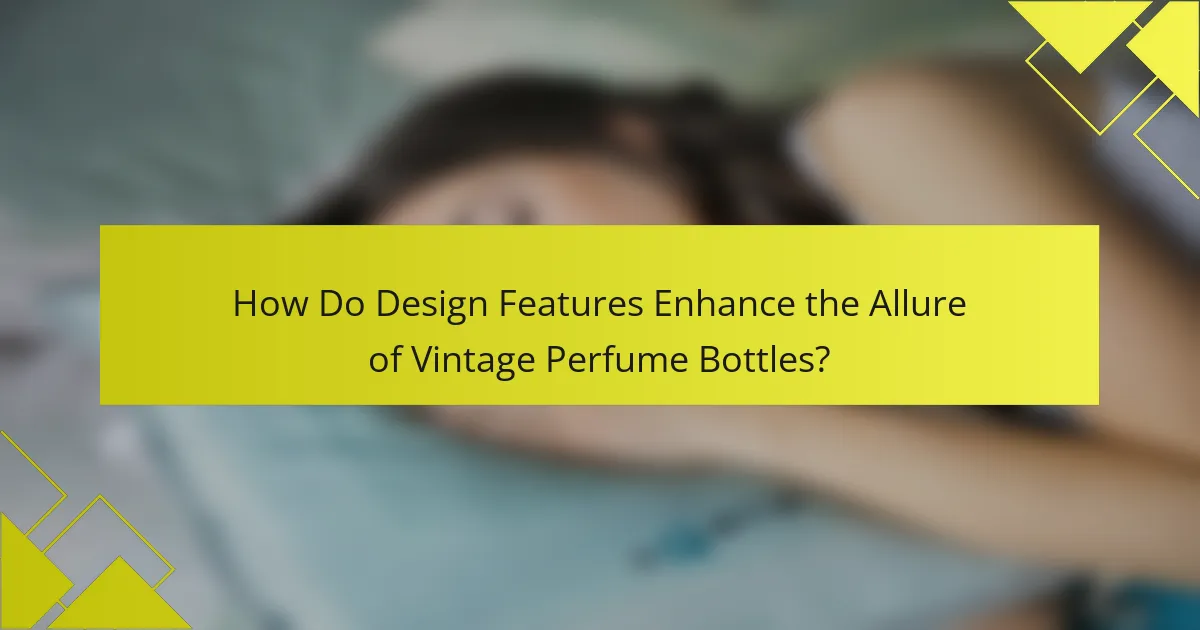
How Do Design Features Enhance the Allure of Vintage Perfume Bottles?
Design features significantly enhance the allure of vintage perfume bottles. Intricate shapes and ornate details capture attention and evoke a sense of artistry. Unique materials, such as cut glass or metal accents, contribute to their visual appeal. The craftsmanship reflects the era of production, adding historical value. Colorful glass and decorative elements often signify luxury and exclusivity. Collectors are drawn to these distinct characteristics, making vintage bottles desirable. Additionally, the nostalgic connection to past trends increases their sentimental value. Overall, design features create a multifaceted allure that attracts enthusiasts and collectors alike.
What are the most notable design elements of vintage perfume bottles?
Vintage perfume bottles are characterized by their intricate design elements. Notable features include ornate shapes that often reflect the artistic styles of their era. Many vintage bottles showcase elaborate glasswork, including cut, etched, or molded designs. Decorative elements such as stoppers, often made of crystal or metal, add to their aesthetic appeal. Some bottles incorporate motifs inspired by nature, like floral or animal shapes. The use of vibrant colors and unique finishes enhances their visual impact. Additionally, labels and packaging often feature vintage typography and artwork, further emphasizing their historical significance. These design elements contribute to the allure and collectibility of vintage perfume bottles.
How do embellishments and artistry play a role in vintage perfume bottle design?
Embellishments and artistry significantly enhance vintage perfume bottle design. These elements create visual appeal and communicate the fragrance’s essence. Intricate designs, such as hand-painted details or ornate caps, reflect craftsmanship and artistic trends of their time. For instance, Art Deco bottles often feature geometric patterns and bold colors, showcasing the era’s aesthetic. Additionally, embellishments like crystals or metal accents elevate the perceived value of the bottle. Historical examples include Lalique’s glasswork, which combines beauty with functionality. Such artistry not only attracts collectors but also adds to the nostalgic charm associated with vintage perfumes.
What role does branding have in the design of vintage perfume bottles?
Branding plays a crucial role in the design of vintage perfume bottles. It influences the aesthetic choices made by designers. Iconic brands often create unique bottle shapes that reflect their identity. For instance, Chanel No. 5 features a minimalist design that emphasizes elegance. This design choice reinforces the brand’s luxury status. Additionally, branding helps evoke nostalgia, appealing to consumers’ emotions. Vintage bottles often incorporate historical branding elements, enhancing their collectibility. Collectors value these bottles not just for the fragrance but for their artistic representation of the brand’s legacy. Ultimately, branding shapes both the visual identity and market perception of vintage perfume bottles.
How do different styles reflect the eras they represent?
Different styles of vintage perfume bottles reflect the eras they represent through distinct design elements and materials. For example, Art Deco bottles feature geometric shapes and bold colors, embodying the 1920s and 1930s fascination with modernity. Meanwhile, Victorian-era bottles often showcase intricate craftsmanship and ornate details, highlighting the period’s emphasis on luxury and femininity.
The materials used also signify the era; glass was prevalent in the 20th century, while earlier bottles were often made from porcelain or metal. Additionally, the size and shape of bottles can indicate societal trends, such as the shift toward more compact designs in the mid-20th century, aligning with changing consumer lifestyles.
Historical context reinforces this relationship; for instance, World War II influenced materials and designs due to resource shortages, leading to simpler forms. Overall, the evolution of styles in vintage perfume bottles serves as a visual narrative of cultural and societal shifts throughout history.
What design trends emerged in different decades for vintage perfume bottles?
In the 1920s, vintage perfume bottles featured Art Deco designs with geometric shapes and bold colors. The 1930s introduced elegant, streamlined forms reflecting modernism and innovation. In the 1940s, bottles became more ornate, often incorporating intricate details and luxurious materials due to post-war prosperity. The 1950s emphasized femininity, with soft curves and pastel colors dominating the designs. By the 1960s, psychedelic patterns and unconventional shapes emerged, reflecting the counterculture movement. The 1970s saw a return to minimalism with clear glass and simple lines. In the 1980s, extravagant and oversized bottles became fashionable, often resembling sculptures. Finally, the 1990s embraced nostalgia with vintage-inspired designs, blending classic elements with contemporary aesthetics.
How do cultural influences shape the design of vintage perfume bottles?
Cultural influences significantly shape the design of vintage perfume bottles. Various cultures contribute distinct artistic styles, materials, and motifs. For instance, Art Deco designs reflect the glamour of the 1920s and 1930s, influenced by modernism and geometric patterns. Additionally, Eastern influences often incorporate intricate details and symbolism, such as floral motifs.
Historical events also impact design trends. The rise of the women’s liberation movement in the 1960s led to more innovative and bold bottle shapes. Materials used in vintage bottles, such as crystal or glass, often reflect regional craftsmanship and availability.
Moreover, marketing strategies are influenced by cultural perceptions of beauty and luxury. For example, French perfume bottles often embody elegance, appealing to high-end markets. This interplay of culture and design creates unique collectible items that resonate with historical and aesthetic significance.
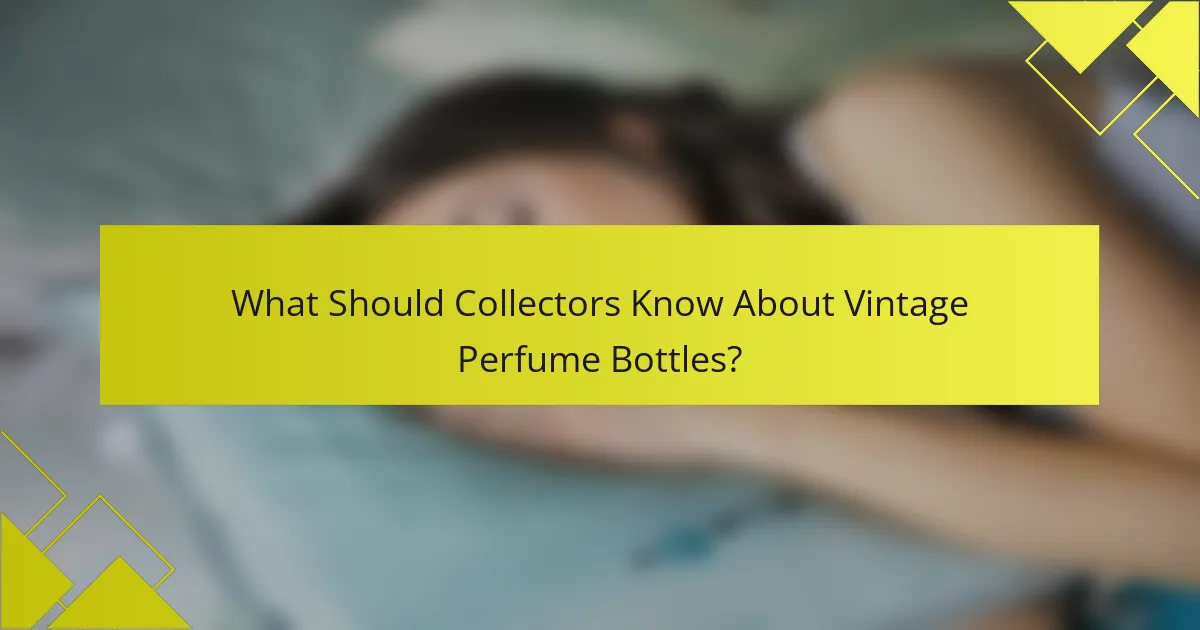
What Should Collectors Know About Vintage Perfume Bottles?
Collectors should know that vintage perfume bottles are highly sought after for their unique designs and historical significance. Many bottles date back to the early 20th century, showcasing intricate craftsmanship and artistic styles. Collectors should pay attention to the brand, as bottles from renowned houses like Chanel or Guerlain tend to have higher value. Condition is crucial; intact bottles with original labels and packaging are more desirable. Rarity also influences value; limited editions or discontinued designs can fetch premium prices. Understanding market trends and participating in collector communities can enhance knowledge and investment potential.
How can collectors identify authentic vintage perfume bottles?
Collectors can identify authentic vintage perfume bottles by examining specific characteristics. Authentic bottles often feature high-quality glass with unique designs. They may have intricate detailing and craftsmanship that is not present in modern replicas. The weight of the bottle can also be a clue; genuine vintage bottles tend to be heavier due to thicker glass.
Additionally, collectors should check for the presence of original labels. These labels often display specific font styles and colors that were used during the bottle’s production era. The packaging, such as boxes or caps, can also provide authenticity clues.
Researching the brand and model can reveal production years and design variations. Reference materials such as collector guides and online databases can aid in this process. Collectors should be wary of common reproduction techniques that mimic vintage styles.
By combining these methods, collectors can increase their chances of identifying authentic vintage perfume bottles accurately.
What are the common signs of authenticity in vintage perfume bottles?
Common signs of authenticity in vintage perfume bottles include the presence of original packaging, unique design features, and specific manufacturing marks. Original packaging often contains brand logos and consistent color schemes. Unique design features may include intricate bottle shapes or rare cap styles. Manufacturing marks, such as etched logos or date codes, can indicate authenticity. Additionally, the quality of materials used, like glass thickness and weight, often reflects the era of production. Research shows that many authentic vintage bottles have distinguishing characteristics that are well-documented in collector guides.
How can collectors research the history of specific vintage perfume bottles?
Collectors can research the history of specific vintage perfume bottles by utilizing various resources. They can start by consulting specialized books on perfume history. These books often detail manufacturers, styles, and timelines. Online databases and auction sites provide valuable information on past sales and bottle descriptions. Joining collector forums and social media groups can facilitate knowledge exchange among enthusiasts. Museums and exhibitions on fragrance history may also offer insights into specific bottles. Additionally, contacting vintage perfume dealers can yield expert information. Researching brand archives can uncover original marketing materials and production details. Each of these methods contributes to a comprehensive understanding of a bottle’s history.
What are the best practices for caring for vintage perfume bottles?
To care for vintage perfume bottles, keep them in a cool, dark place. Avoid direct sunlight, as it can degrade the liquid and damage the bottle. Store bottles upright to prevent leakage and preserve the scent. Clean bottles gently with a soft, dry cloth to avoid scratches. Do not use harsh chemicals or water, as these can harm the materials. Regularly check for signs of deterioration, such as cracks or leaks. If the perfume is still in the bottle, avoid frequent opening to maintain its integrity. Proper care can extend the life of both the bottle and its contents.
How should collectors clean and maintain their vintage perfume bottles?
Collectors should clean vintage perfume bottles with care to avoid damage. Use a soft, lint-free cloth to wipe the exterior gently. For stubborn residue, mix mild soap with warm water. Dampen the cloth with the soapy solution and clean the bottle. Rinse the cloth and wipe off any soap residue with clean water. Avoid submerging the bottle in water, as this can damage the seals and labels. For maintenance, store bottles upright in a cool, dark place to prevent fading and deterioration. Regularly check for leaks or deterioration in seals to ensure longevity.
What storage conditions are ideal for preserving vintage perfume bottles?
Ideal storage conditions for preserving vintage perfume bottles include a cool, dark, and dry environment. Exposure to light can degrade the fragrance and damage the bottle. Temperatures should ideally range between 15°C to 20°C (59°F to 68°F). High humidity levels can also lead to mold growth and label deterioration. It is essential to store the bottles upright to prevent leakage. Using padded boxes or soft cloths can protect against scratches. Avoiding areas with temperature fluctuations, such as near windows or heating vents, is crucial. These practices help maintain the integrity and value of vintage perfume bottles.
What resources are available for vintage perfume bottle collectors?
Vintage perfume bottle collectors have access to various resources. Key resources include online marketplaces like eBay and Etsy. These platforms offer a wide selection of vintage bottles. Specialty auction houses also frequently feature vintage perfume bottles. Collectors can find detailed catalogs and listings there. Additionally, dedicated collector forums and social media groups provide community support. These platforms facilitate sharing knowledge and trade opportunities. Books on vintage perfume bottles are valuable for historical context. Such books often include images and detailed descriptions. Collectors can also attend antique shows for direct purchasing opportunities.
How can online communities enhance the collecting experience for vintage perfume bottle enthusiasts?
Online communities enhance the collecting experience for vintage perfume bottle enthusiasts by providing platforms for knowledge sharing and networking. These communities allow collectors to exchange information about rare finds and market trends. Members can ask questions and receive advice from experienced collectors, which fosters learning. Online forums and social media groups facilitate discussions about design features and historical significance. Collectors can showcase their collections, gaining recognition and feedback. Additionally, these communities often host virtual events or sales, connecting buyers and sellers directly. This access to a wider audience increases opportunities for trading and acquiring unique bottles. Overall, online communities create a supportive environment that enriches the collecting journey for enthusiasts.
What books or guides are recommended for learning more about vintage perfume bottles?
“Collecting Perfume Bottles” by John A. T. O’Brien is a recommended guide. It covers history, design, and collecting tips. “The Perfume Bottle Book” by Michael J. O’Neill provides illustrations and details on various styles. “Perfume Bottles: A Collector’s Guide” by Judith K. H. Heller includes valuable insights on vintage pieces. These books are well-regarded in the collecting community. They offer comprehensive information for enthusiasts and collectors alike.
The main entity of this article is vintage perfume bottles, which are characterized by their unique designs, historical significance, and collectibility. The article explores the allure of these bottles, highlighting their intricate craftsmanship, materials, and the nostalgia they evoke. It discusses how historical events and cultural influences shaped their design, as well as common features that enhance their appeal. Additionally, the article provides insights into factors that determine their value, best practices for collectors, and resources available for those interested in vintage perfume bottles.
